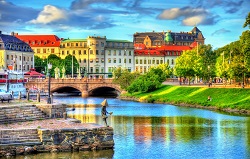Building inclusive public spaces
From the main square in a major city to shared spaces in apartment blocks, public areas are used by different people in a multitude of different ways. Planning how to design these spaces to be as inclusive as possible was the core focus of EU-funded project TRADERS. The project saw artists and designers engage with users of public spaces in unique and innovative ways, gaining fresh insights into how they feel when in a public zone. The findings were then taken up by the authorities in charge of planning the spaces. ‘From groups of people found on the fringes of society to children, the way people feel and act in a public space is underexplored. TRADERS tested and developed a set of participatory and engaging research methods which art and design researchers can use to explore the human side when working on researching public space,’ says Jessica Schoffelen, TRADERS co-project coordinator. The project trained five early stage art and design researchers and one sociological researcher on participatory research methods including intervention – or new ways of getting people to take part – specifically focussing on children and performative mapping, essentially getting people to map how they feel in public spaces. In one project, artist Pablo Calderón Salazar focussed on the Belgian city of Genk which has recently suffered from the closure of a Ford factory forcing a considerable number of people into unemployment. In a bid to spark debate about work and help people explore new job opportunities, Salazar created a bike designed to hold a printing press. He travelled around the public spaces in Genk talking to people about how they conceive work. Using his printing press, he helped people make posters displaying their skills. He also collated the skill sets he found on a blog hoping to build connections between people. In Gothenburg, Sweden, designer Annelies Vaneycken explored children’s’ play. Instead of allowing adults to design inclusive public spaces, Vaneycken got the children themselves involved, contributing their own ideas about areas designed for their use. Another project saw designer Naomi Bueno de Mesquita create a smart phone app which allows people to map how they use public spaces. She focussed on marginalised groups like refugees, mapping their emotions in different parts of public spaces. She found, for example, that refugees feel uncomfortable in areas with a lot of security cameras. Her work allows other people, including public space planners, to experience what other people feel in public spaces. ‘TRADERS was all about participation and inclusivity through the arts. We built a community of people involved in the design of public spaces, creating social insights they may not have had access to before,’ says Veerle Van der Sluys, TRADERS co-coordinator. Throughout the project TRADERS organised several public events on participatory art and design. The events, which attracted designers, local organisations and authorities, explored ways to boost citizen participation, how artists and designers can make a difference via their work, and how they can empower others to bring about social or political change. The project also produced a book on its findings called ‘Trading Places: Practices of Public Participation in Art and Design Research.’
Keywords
TRADERS, art and design, public space, play areas, unemployment, marginalised groups



